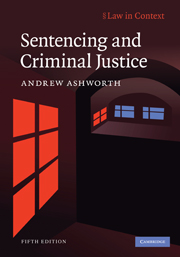Book contents
- Frontmatter
- Contents
- Preface
- Table of legislative measures
- Table of cases
- 1 An introduction to English sentencing
- 2 Sentencing and the constitution
- 3 Sentencing aims, principles and policies
- 4 Elements of proportionality
- 5 Aggravation and mitigation
- 6 Persistence, prevention and prediction
- 7 Equality before the law
- 8 Multiple offenders
- 9 Custodial sentencing
- 10 Non-custodial sentencing
- 11 Procedural issues and ancillary orders
- 12 Special sentencing powers
- 13 Conclusions
- Appendix: The Sentencing Council: provisions in the Coroners and Justice Act 2009
- References
- Index
6 - Persistence, prevention and prediction
Published online by Cambridge University Press: 05 June 2012
- Frontmatter
- Contents
- Preface
- Table of legislative measures
- Table of cases
- 1 An introduction to English sentencing
- 2 Sentencing and the constitution
- 3 Sentencing aims, principles and policies
- 4 Elements of proportionality
- 5 Aggravation and mitigation
- 6 Persistence, prevention and prediction
- 7 Equality before the law
- 8 Multiple offenders
- 9 Custodial sentencing
- 10 Non-custodial sentencing
- 11 Procedural issues and ancillary orders
- 12 Special sentencing powers
- 13 Conclusions
- Appendix: The Sentencing Council: provisions in the Coroners and Justice Act 2009
- References
- Index
Summary
The focus of this chapter is upon the controversial question of sentencing repeat offenders, including the sub-group of ‘dangerous offenders’. After a brief historical introduction, part 6.2 explores four approaches to sentencing persistent offenders, and part 6.3 considers the relevant provisions of the Criminal Justice Act 2003. Parts 6.4 and 6.5 examine two specific problems, those of ‘professional’ criminals and of petty persistent offenders. In part 6.6 a different approach to preventing repetition is examined – the use of anti-social behaviour orders. Part 6.7 of the chapter turns to the question of selective incapacitation as a strategy for preventing crime, referring to the minimum ‘three strikes’ sentences in English law. In part 6.8 the ‘dangerousness’ provisions of the 2003 Act (as amended in 2008) are examined, and some concluding thoughts are found in part 6.9. Throughout these topics there are linking themes concerned with the promotion of security and the assessment of risk of future criminal behaviour. The invocation of such rationales amounts to a departure from the proportionality principle, and close attention will be paid to the justifications for this.
Historical introduction
The history of English measures aimed specifically at persistent offenders seems to be widely acknowledged to be a history of failure. The judges have had sufficient discretion, for the last hundred years at least, to allow them to pass fairly long sentences on persistent serious criminals without invoking any special powers.
- Type
- Chapter
- Information
- Sentencing and Criminal Justice , pp. 195 - 238Publisher: Cambridge University PressPrint publication year: 2010

